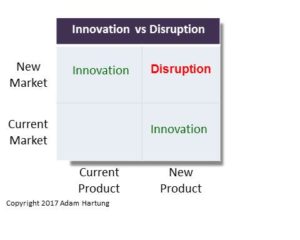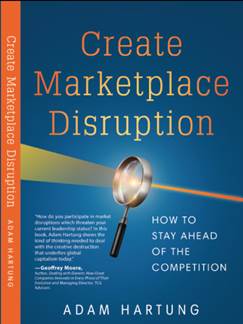The newsletters of Adam Hartung.
Keynote Speaker, Managing Partner, Author on Trends

Succeeding at Innovation Prepares your Team for Disruption
Nearly every organization has woven innovation into its mission and innovation management into its day-to-day operations. The combination of creativity and innovation leads to higher performance, sales and profits. The business media, B-schools and researchers have devoted much of their attention to the most dramatic form of innovation- “disruptive innovation.” These events are infrequent, but cause huge changes in the market and for consumers. Because of this focus, the terms “innovation”and “disruption” are nearly synonymous to most people.
Ansoff Matrix is Really an Innovation Roadmap
 The Ansoff Matrix pictures how a company can expand from its current offering with customers and markets to new markets and existing new products. The upper right hand corner is a “white space” where disruptive innovations live. Today’s business culture has made this the ultimate goal. And I’ve written at length about how to manage white space.
The Ansoff Matrix pictures how a company can expand from its current offering with customers and markets to new markets and existing new products. The upper right hand corner is a “white space” where disruptive innovations live. Today’s business culture has made this the ultimate goal. And I’ve written at length about how to manage white space.
But what about new products like LED flashlights, families of cordless tools using the same battery, the touch faucet, the foot-activated tail gate,the Gatorade “G-series” of drinks or even the pod coffee brewer (i.e. Keurig)? Were they “disruptive”?
- The “G-Series” of sports drinks created a new brand, but didn’t expand the sports drink market. They did not identify an unmet market segment and exploit it.
- The hands free tail gate was based in part on aseries of patents dating from 1983, but didn’t expand the market for SUVs. It just made those SUVs easier to use, andmore desirable by consumers.
- The Keurig brand pod coffee brewer, while now used by up to 30% of households, didchange brewing patterns and reduced the market for larger coffee brewers. But it did not expand the market for coffee in the US! (source USDA). It merely made coffee making easier for those who already drank coffee.
These products were all profitable and popular, but they were not disruptive- they were “innovations.” They fit into the two New/Current boxes in the Ansoff Matrix.
Companies want to duplicate these successes in their own businesses. But when they ask for advice on “disruption”, they often find they are not ready for the commitment and this type of risk. Most companies discover that the jump from Current/Current to New/New in one step is very difficult. If attempted at all, it is usually done to meet some newly identified trends.
Thinking that innovation = disruption, causes organizations to retreat back to Current/Current. The result is “better sameness” as Guy Kawasaki labeled the phenomenon- not real innovation, just slight improvements to existing products.
So what’s the path for product and marketing managers that need to get out of the Current/Current box, but aren’t ready to make the jump to truly disruptive innovation?
Innovation as a Profitable Step Toward Disruption
We call it: “The Ansoff L”. The two boxes next to the current position are where this type of innovation takes place.
 Projects in these areas are easier to understand, and often feel like they are lower risk because at least half of the “newness equation”is known. And can certainly contribute much to growth. And, best of all, they frequently require less resources and can be implemented without the CEO’s involvement. Planning and implementation can occur much lower in the organization.
Projects in these areas are easier to understand, and often feel like they are lower risk because at least half of the “newness equation”is known. And can certainly contribute much to growth. And, best of all, they frequently require less resources and can be implemented without the CEO’s involvement. Planning and implementation can occur much lower in the organization.
The “Ansoff L” gives the company a framework for creating and managing simpler innovations based on existing knowledge. The projects also allow the company to learn,building a stronger knowledge base for reducing the risk in pursuing future, more “disruptive” projects.
Creating value with the “Ansoff L” still requires analysis of trends and competitors, a thorough understanding of “actions of the customer”, and a new product development and launch process. So, it’s not obvious nor guaranteed. And it may not be a sexy as “disruptive innovation”, but success with innovation projects in the Ansoff L improves confidence in innovation management and prepares the company for major breakthroughs in the future.
Add me to the email list!
“The enterprise that does not innovate ages and declines. And, in a period of rapid change such as the present, the decline will be fast.”
Peter Drucker
Actions you can take
Don’t hesitate to ask for help in making your organization more adaptable, and your strategy embedded with options to pivot based on market shifts. You could start with an underperforming product or brand. Practice the “pivot” and learn how to implement change. And ask for coaching.
Watch my video discussing Netflix’ adaptable strategy and skill at pivoting.
How we can help
Our two decades of helping organizations identify and implement innovations gives us keen insight into how sustaining, expanding and disruptive innovations can be identified, evaluated for risk and cost, and managed for successful market growth. Our experience and processes will help you grow via innovation with more confidence, less time investment, lower cost and faster, greater returns.
For more on how to include trends in your planning, I’ve created a “how-to” that you can adapt for your team. See my Status Quo Risk Management Playbook.
Give us a call today, or send an email, so we can talk about how you can be a leader, rather than follower, in 2017 and beyond. Or check out the rest of the website to read up on what we do so we can create the right level of engagement for you.
Related Newsletters
Forbes Posts- Hartung on Leadership, Investing, Trends



